Mattress Pads
Can I Put a Mattress Pad Over a Heated Mattress Pad
Get ready to double up your comfort with a mattress pad over a heated pad – find out the best tips and tricks for the ultimate cozy sleep experience!
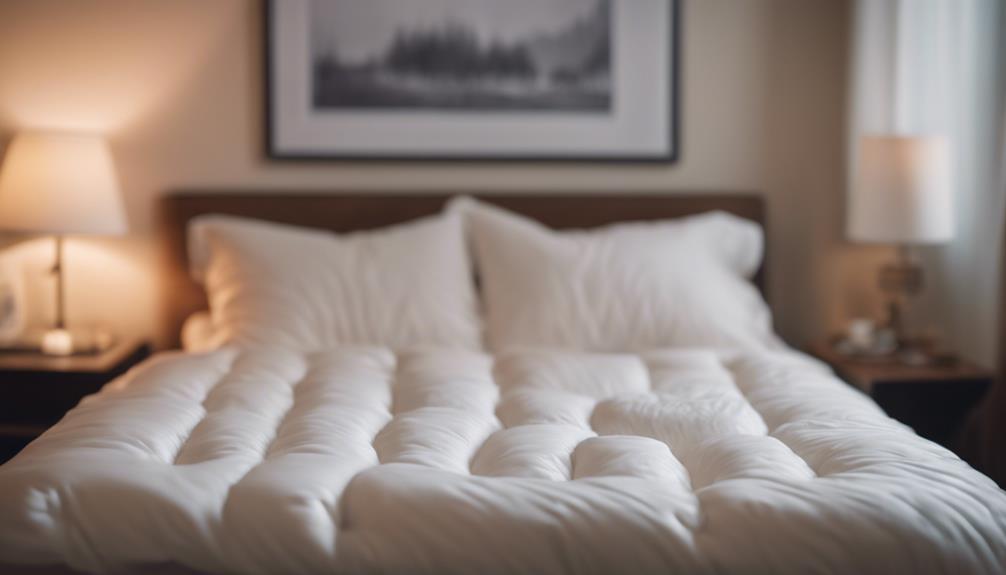
Yes, you can layer a mattress pad over a heated mattress pad. However, it’s important to consider compatibility. Opt for a thinner, breathable pad to prevent heat trapping and ensure a proper fit. Experiment with different combinations for optimal comfort. Thicker pads may reduce the warmth felt, so finding a balance is crucial. Proper maintenance practices can help prolong the longevity of the pad and protect against wear. Cleaning both pads separately and selecting a washable one simplifies maintenance. Layering provides enhanced comfort, but it’s essential to consider thickness and material. For more tips on the best layering and maintenance, discover how to maximize cozy sleep experiences.
Key Takeaways
- Consider the thickness of both pads for proper heat transfer.
- Opt for a breathable pad to prevent heat trapping.
- Ensure the pads fit well to avoid shifting.
- Check compatibility with controls and wiring for safety.
- Experiment with combinations for the ideal comfort level.
Compatibility Considerations for Layering Mattress Pads
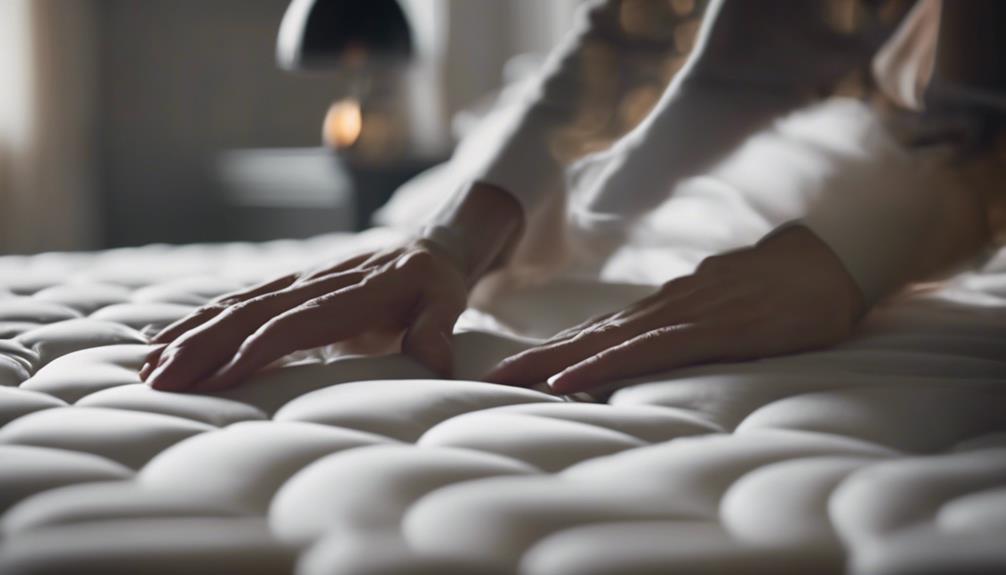
When layering a mattress pad over a heated mattress pad, it's important to take into account compatibility factors that impact heat transfer and overall comfort. The thickness and material of the top mattress pad play a significant role in regulating heat. Thicker pads may trap heat, leading to discomfort or even safety hazards, so opting for a thinner, breathable option is advisable.
Ensuring a proper fit and placement is essential to prevent any shifting or bunching of the pads, which could disrupt the heat distribution and comfort levels.
Checking the manufacturer's guidelines for compatibility and safety is essential when layering pads. Different brands and models may have specific recommendations to optimize performance and prevent damage. Experimenting with various combinations can help find the perfect balance between warmth and cushioning, enhancing the overall sleeping experience.
Benefits of Adding a Mattress Pad

Adding a mattress pad enhances the comfort and durability of your bed while also providing temperature regulation benefits. Not only does it offer an extra layer of softness for a more cozy sleep experience, but it also acts as a shield, protecting your heated mattress pad and extending its lifespan.
The temperature regulation properties of a mattress pad guarantee that you stay comfortable throughout the night, avoiding overheating or feeling too cold. Some mattress pads even come with special features like waterproofing to guard against spills and cooling properties to help you stay cool during warmer nights.
Choosing a Suitable Mattress Pad
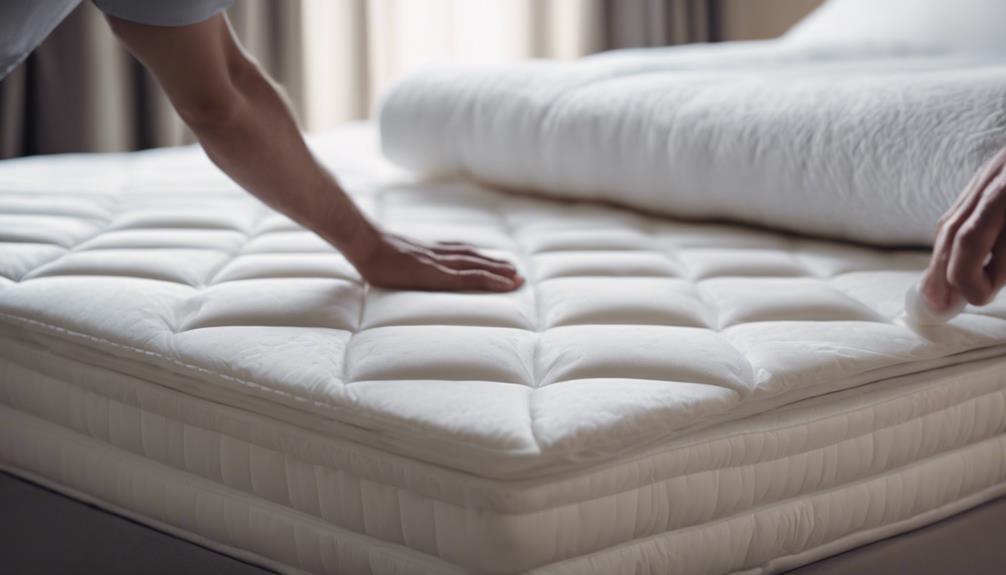
To choose an appropriate mattress pad, concentrate on the thickness and material to guarantee compatibility with the underlying heated mattress pad. When selecting a mattress pad to layer over your heated mattress pad, opt for one that's breathable and moisture-wicking. These features not only enhance comfort but also help in distributing heat evenly throughout the night.
A fitted design is important to prevent the pad from shifting, ensuring a smooth sleeping surface without any discomfort. It's essential to check for compatibility with the heated mattress pad's controls and wiring to prevent any interference that could affect its performance. Additionally, choosing a washable mattress pad allows for easy maintenance, keeping your sleeping environment clean and hygienic.
Ensuring Proper Heat Transfer
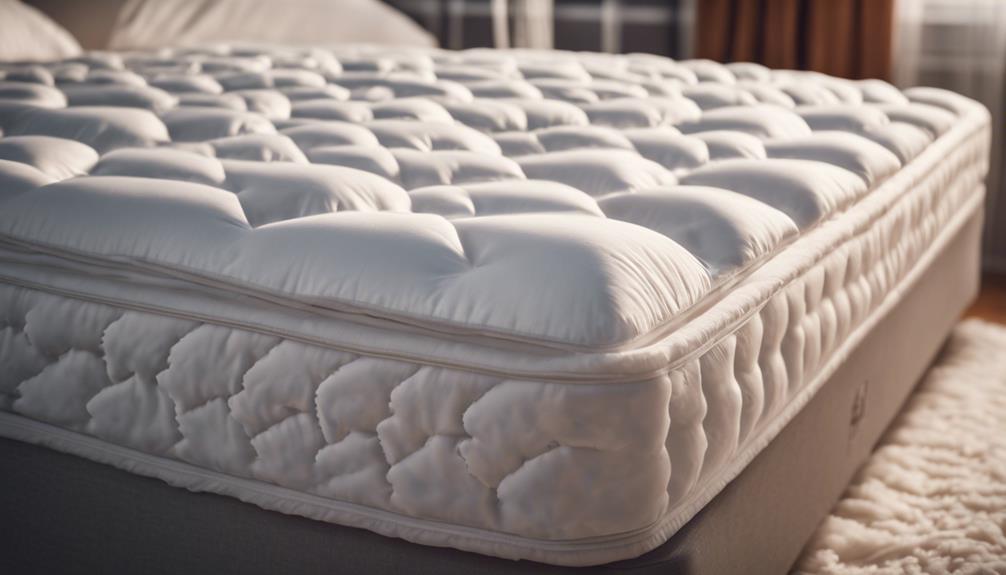
Placing a mattress pad over a heated mattress pad can impact the direct heat transfer experienced while sleeping. The additional pad acts as a barrier, potentially reducing the warmth felt from the heated pad. Thicker mattress pads can further diminish heat transfer, affecting the overall comfort and warmth. To guarantee proper heat transfer and balance between cushioning and warmth, consider using a thinner mattress pad on top of the heated one. Experimenting with different combinations will help find the ideal setup for a good night's sleep.
| Mattress Pad | Heat Transfer | Comfort Level |
|---|---|---|
| Thin | Higher | Ideal |
| Thick | Lower | Reduced |
| Heated | Variable | Cozy |
Maintaining Mattress Pad Longevity
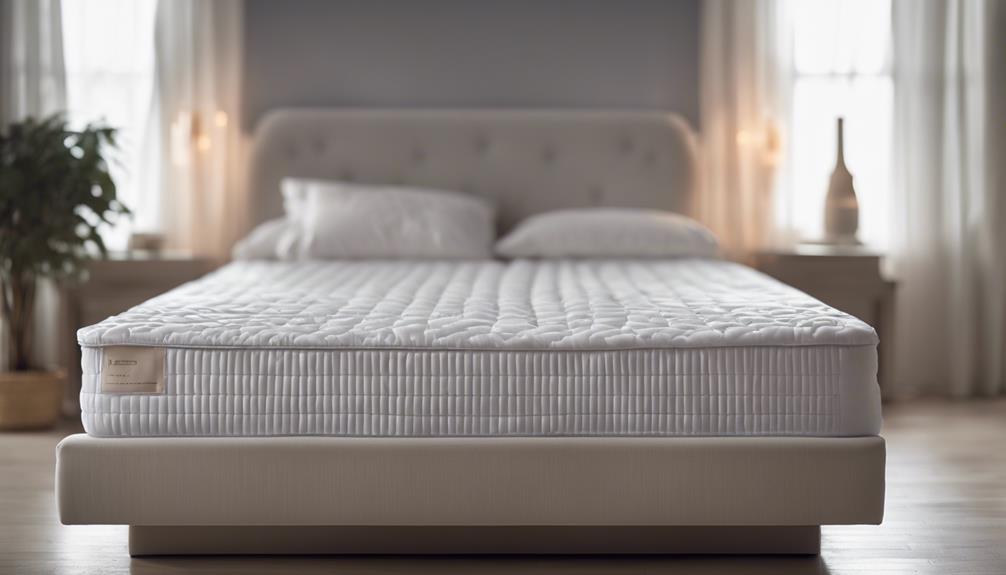
Let's secure the longevity of your mattress pad by implementing proper maintenance practices. Using a mattress pad over a heated pad can extend the lifespan of your bedding by providing an additional layer of protection. This shielding helps safeguard your heated pad from everyday wear and tear, ensuring it stays in top condition for longer.
It's important to choose a mattress pad that's compatible with a heated pad to prevent any overheating issues or safety concerns. In addition to enhancing comfort, a mattress pad acts as a barrier against spills, stains, and allergens, making cleaning easier and protecting your investment.
Cleaning and Care Tips
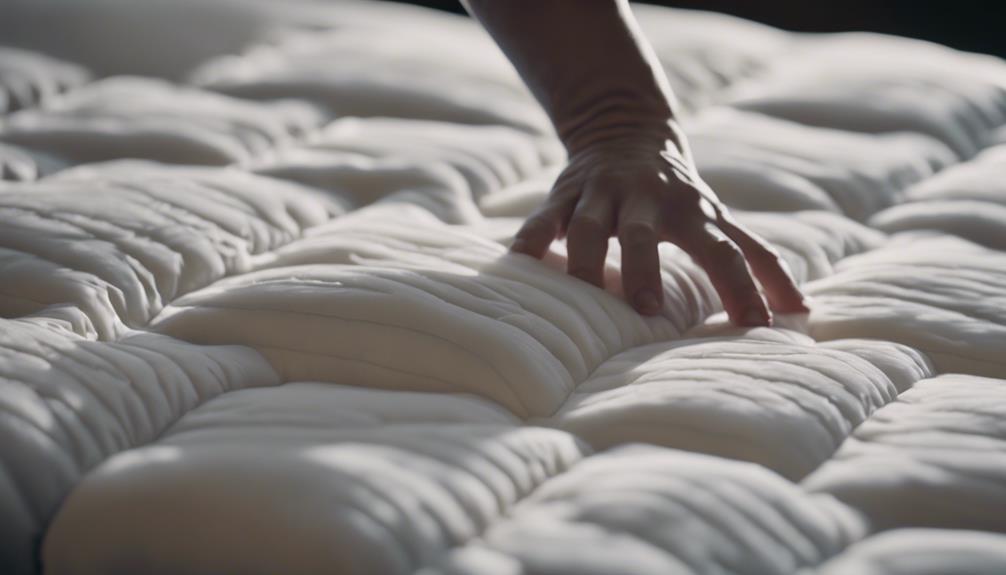
When maintaining both a mattress pad and a heated pad, it is important to follow specific cleaning and care tips to guarantee their longevity and efficiency. Regularly clean both the mattress pad and heated pad separately to maintain hygiene and ensure peak performance. Checking the manufacturer's instructions is vital to confirm compatibility between the electric blanket and any additional mattress pad used for extra warmth and comfort. Adding an extra layer with a regular mattress pad not only offers a cozy sleep experience but also helps extend the life of the heated pad by providing a barrier against wear and tear. By following proper care guidelines and keeping both pads clean, you can enjoy a comfortable and durable bedding setup. Below is a table summarizing key cleaning and care tips for maintaining both your mattress pad and heated pad:
| Cleaning and Care Tips | Benefit |
|---|---|
| Regularly clean both the mattress pad and heated pad separately | Maintains hygiene and efficiency |
| Check manufacturer's instructions for compatibility with additional mattress pads | Ensures proper use and safety |
| Use an extra mattress pad as a barrier against wear and tear | Extends the life of the heated pad |
| Enjoy a cozy sleep experience with added comfort | Provides extra warmth and cushioning |
Layering Options for Enhanced Comfort
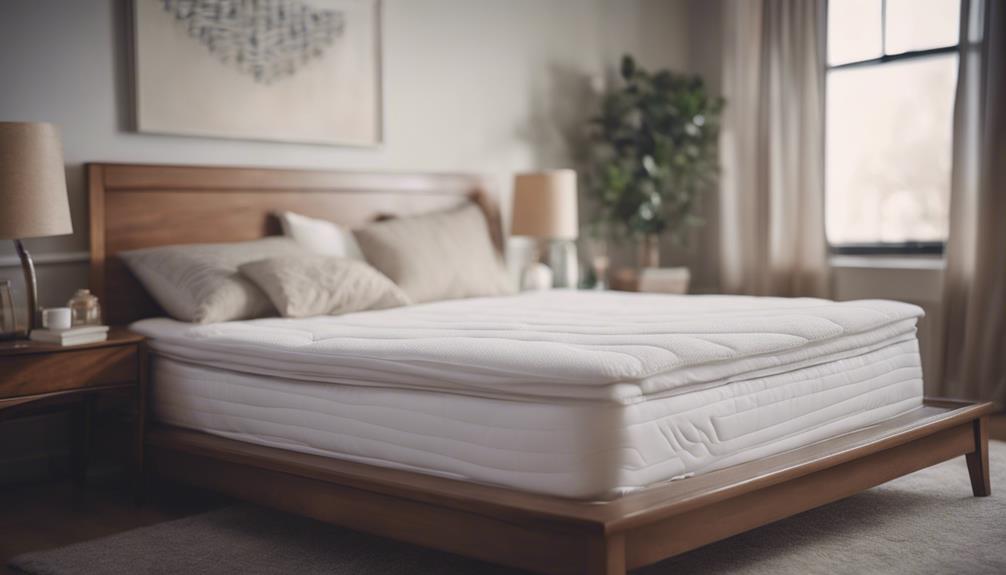
We can enhance the comfort of our bedding setup by layering a mattress pad over a heated pad for additional cushioning and coziness. When considering this option, it's important to pay attention to the thickness of both pads to make sure they fit well on the bed without shifting during use. By adding a mattress pad over a heated mattress pad, not only do we increase comfort, but we also provide extra protection to the heated pad, potentially extending its lifespan.
To optimize comfort further, choosing a breathable and moisture-wicking mattress pad can enhance airflow and regulate temperature, creating a more comfortable sleep environment. It's vital to check the manufacturer's guidelines to guarantee compatibility and safe usage of multiple bedding layers. By selecting the right combination of pads that work well together, we can achieve a luxurious and cozy sleeping experience that meets our comfort needs.
Frequently Asked Questions
Does a Mattress Pad Go Over or Under a Heated Mattress Pad?
Yes, a mattress pad typically goes over a heated mattress pad for extra comfort and protection. The regular pad adds a cozy layer between you and the heat source, enhancing your sleeping experience.
To guarantee proper heat distribution, choose a mattress pad that works well with the heated one. Opt for a breathable or moisture-wicking pad to maintain the benefits of the heated pad underneath.
Can You Put a Sheet on Top of a Heated Mattress Pad?
Yes, placing a sheet on top of a heated mattress pad is a fantastic idea! It not only adds an extra layer of comfort but also helps maintain cleanliness and protects the pad.
The sheet acts as a barrier between you and the heating elements, making your sleep experience cozy and safe.
Plus, it's easy to wash, keeping your bedding fresh. So go ahead and add that sheet for a luxurious and practical sleep setup!
Can You Put a Mattress Topper Over a Heated Blanket?
Yes, you can place a mattress topper over a heated blanket to enhance both comfort and warmth. The topper enhances cushioning and support, while the blanket provides cozy heat.
Just make sure the blanket is thin enough for the topper to sit evenly. Consider the topper's thickness and material to avoid affecting heat distribution.
With this combo, you'll enjoy a plush sleeping surface with that extra warmth for a restful night's sleep.
Can You Use a Heated Mattress Pad With a Memory Foam Pad?
Yes, using a heated mattress pad with a memory foam pad can lead to issues. The direct heat exposure might degrade the foam over time, affecting its performance and longevity. Memory foam mattresses respond to body heat for comfort, but extra heat sources like heated pads can disrupt this balance.
This can be a safety concern too, as memory foam releases dangerous gases when exposed to fire. It's advised to avoid using heated pads on memory foam mattresses to prevent damage and warranty issues.
Is it Safe to Use a Cooling Mattress Pad Over a Heated Mattress Pad?
When it comes to cooling mattress pad safety, using a cooling mattress pad over a heated mattress pad can pose certain risks. The combined use of the two pads can lead to overheating and potentially cause discomfort or even safety hazards. It is best to use them separately for optimal safety and comfort.
Conclusion
To sum up, layering a mattress pad over a heated mattress pad can provide added comfort and protection for your bed. By choosing compatible pads and ensuring proper heat transfer, you can create a cozy sleep environment.
With regular cleaning and care, your mattress pads can last longer and continue to enhance your sleeping experience. So go ahead, double up on the comfort and enjoy a restful night's sleep like never before!
Mattress Pads
What Is a Crib Mattress Pad
Keen to safeguard your baby's mattress? Explore how a crib mattress pad offers protection and comfort, ensuring a cozy sleep environment.
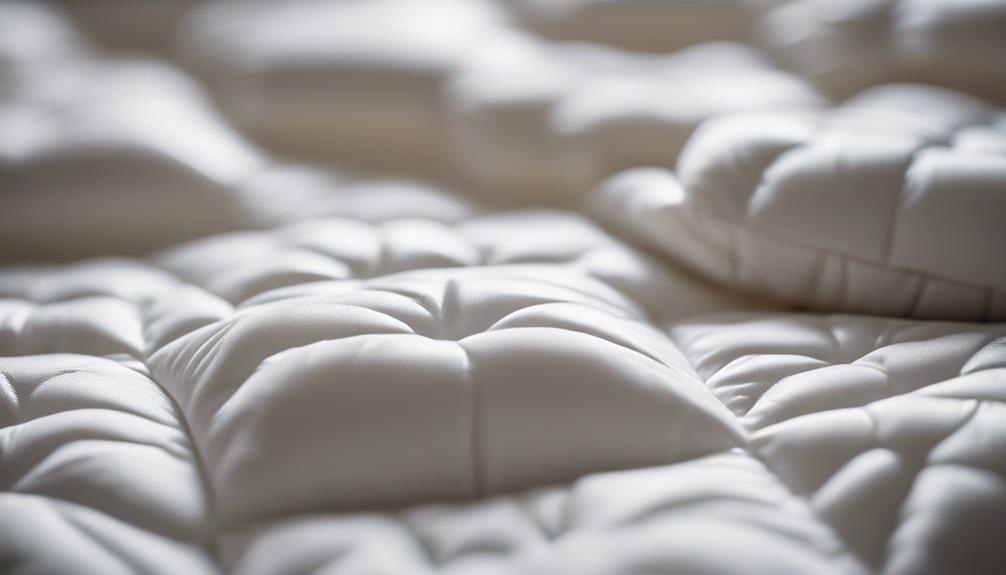
A crib mattress pad serves as a protective layer to guard the mattress against spills and accidents, ensuring a clean and comfortable sleeping area for babies. It provides comfort and helps keep the mattress in good condition, improving the overall sleep experience. With a waterproof feature, it prevents liquid seepage, protecting against mold and bacteria buildup. The pad promotes better hygiene and helps create a healthier environment for infants. Familiarizing yourself with the benefits and materials used in crib mattress pads can help you choose the best option for your baby’s needs. Explore key factors for selecting the perfect crib mattress pad for your little one.
Key Takeaways
- A crib mattress pad is a protective layer for cribs.
- It safeguards the mattress from spills and accidents.
- Offers comfort and maintains a hygienic sleeping environment.
- Can be waterproof to prevent liquid seepage.
- Promotes better hygiene and creates a healthier sleeping space for babies.
Importance of Crib Mattress Pads
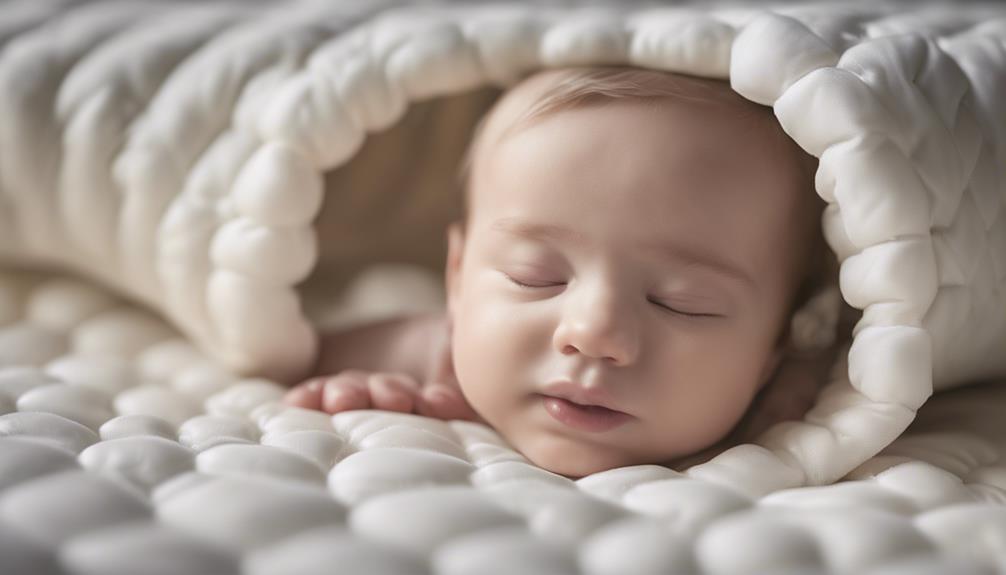
Crib mattress pads play an essential role in safeguarding the mattress from spills and accidents while maintaining a hygienic sleeping environment for infants.
These pads not only offer comfort but also guarantee that the mattress remains in top condition. The waterproof feature is vital as it prevents liquid from seeping through, protecting the mattress from mold, bacteria, and allergens.
By maintaining a dry surface, waterproof pads promote better hygiene and create a healthier sleeping space for babies. Additionally, the ease of maintenance is a significant advantage.
Following washing instructions, using gentle detergents, and periodically airing out the pad in the sun helps to extend its lifespan and keep it fresh.
Benefits of Using a Mattress Pad

When considering the benefits of using a crib mattress pad, it's crucial to note the enhanced comfort layer it provides for the baby, ensuring a cozy and peaceful sleep environment.
Additionally, these pads offer protection against spills, stains, and accidents, safeguarding the mattress and extending its lifespan.
Enhanced Comfort Layer
Enhancing the comfort level of a baby's sleep environment, a crib mattress pad serves as a supportive cushion beneath the fitted sheet.
- The soft padding of the mattress pad provides an extra layer of comfort for the baby to rest peacefully.
- It helps in promoting better sleep quality by offering a cozy and gentle surface for the baby to lie on.
- The added cushioning can alleviate pressure points, ensuring a more relaxing and comfortable sleep experience.
- By enhancing the overall comfort of the crib, the mattress pad enables the baby to enjoy a soothing and undisturbed rest, contributing to their well-being.
Protection Against Spills
To maintain a clean and hygienic sleeping surface for the baby, crib mattress pads offer essential protection against spills, leaks, and accidents. These waterproof mattress pads act as a barrier, preventing fluids from seeping into the mattress, thereby keeping it free from stains and odors.
The breathable crib mattress pads with their waterproof barriers and stain-repellent quilted tops are designed to provide a sanitary sleeping environment for the baby. In case of any accidents, having a machine washable mattress pad makes cleanup a breeze, ensuring quick and easy maintenance.
Extend Mattress Lifespan
Using a crib mattress pad helps safeguard the mattress from spills and stains, thereby prolonging its lifespan and maintaining a clean sleeping environment for the baby.
Crib mattress pads provide several benefits that help extend the mattress lifespan:
- Acting as a protective barrier against spills and stains.
- Maintaining the hygiene of the mattress, preventing it from getting soiled.
- Reducing the frequency of deep cleaning or replacing the mattress.
- Adding an extra layer of comfort for the baby to sleep on.
Factors to Consider When Choosing
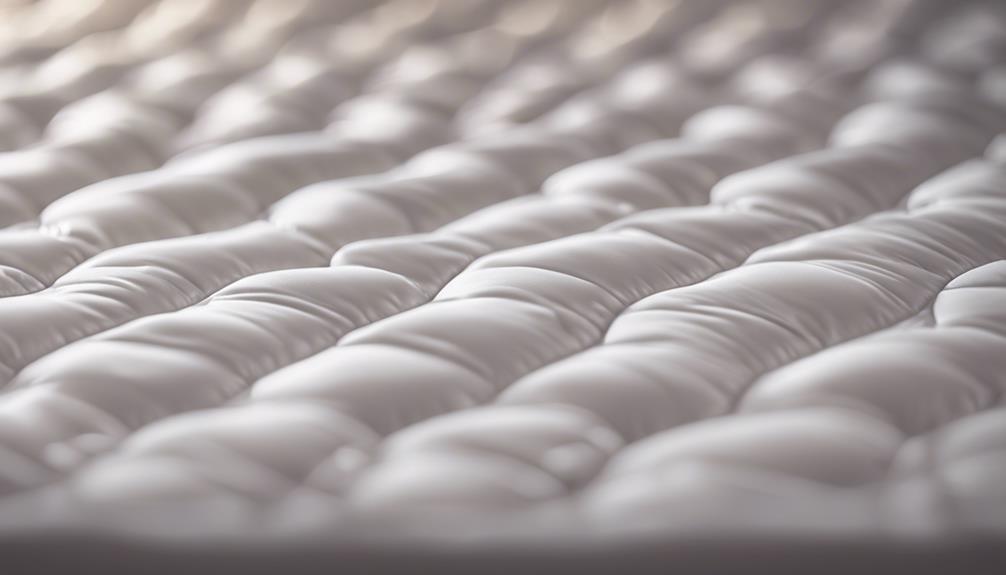
When selecting a crib mattress pad, we need to take into account the material options available and the waterproof features it offers.
These factors are vital in ensuring the pad is both comfortable for the baby and easy to clean for parents.
Material Options
Considering material options when choosing a crib mattress pad is essential for ensuring safety and comfort for your baby. Here are some factors to keep in mind:
- Organic Cotton: Opt for this natural, hypoallergenic material for a gentle touch on your baby's skin.
- Waterproof Materials: Look for pads with waterproof layers to protect the mattress from spills and accidents.
- Breathable Fabrics: Choose pads made from breathable fabrics to help regulate temperature and prevent overheating.
- Machine-Washable Options: Select pads that are easy to clean in the washing machine for convenience and hygiene.
Waterproof Features
When selecting a crib mattress pad, the waterproof features play an important role in safeguarding the mattress from liquid infiltration and maintaining a sanitary sleeping surface for your baby.
A waterproof mattress cover prevents leaks, spills, and accidents from seeping into the mattress, thereby protecting it from damage.
By keeping moisture out, these features also help prevent mold, bacteria, and allergens from developing, creating a healthier sleep environment for your little one.
Choosing a waterproof pad not only ensures easy cleaning and maintenance but also helps extend the lifespan of the mattress.
Ultimately, investing in a mattress pad with excellent waterproof qualities is essential for ensuring a hygienic sleeping surface and providing your baby with a comfortable and safe place to rest.
Types of Materials Used
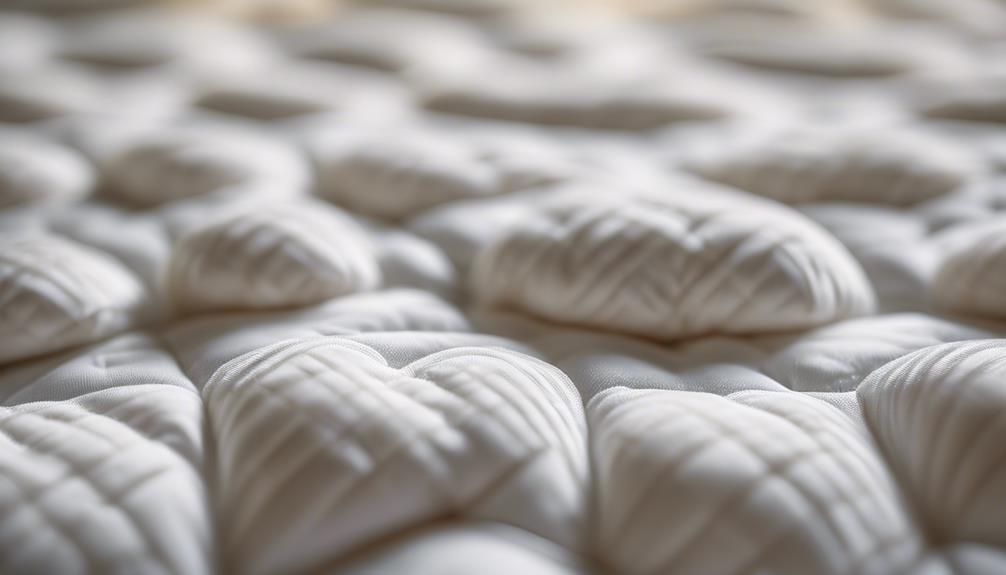
Various materials are utilized in the creation of crib mattress pads, each offering distinct advantages for the comfort and safety of infants and toddlers. Here are some common materials used in crib mattress pads:
- Organic Cotton: Known for being hypoallergenic and chemical-free, organic cotton pads provide a natural and safe sleeping surface for babies, ensuring a cozy and healthy environment.
- Polyester Blends: These pads offer durability and water resistance, making them easy to clean and maintain. They provide a protective barrier against spills and accidents, keeping the mattress underneath safe and dry.
- Bamboo: Breathable and moisture-wicking, bamboo mattress pads promote airflow and create a comfortable sleep environment for little ones. They're also eco-friendly, making them a sustainable choice for parents looking to reduce their environmental impact.
- Hypoallergenic: Many crib mattress pads are designed to be hypoallergenic, preventing potential allergic reactions and ensuring a safe and comfortable sleep for babies with sensitive skin.
Waterproof Vs. Non-Waterproof Pads
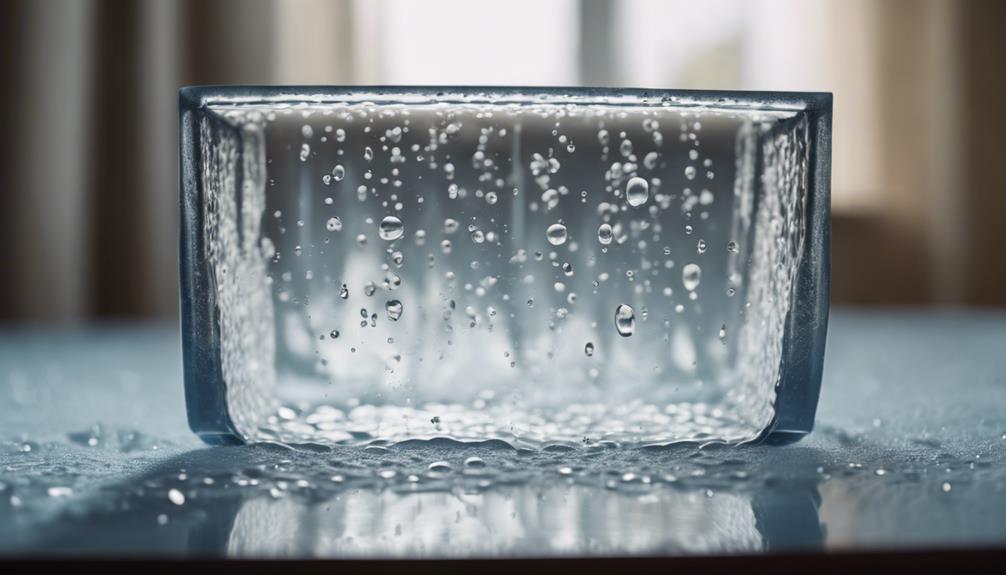
We explored the different materials used in crib mattress pads; now let's compare the benefits of waterproof and non-waterproof options for these essential baby bedding accessories. When deciding between waterproof and non-waterproof crib mattress pads, it's important to take into account the level of protection and comfort they offer. Below is a comparison table highlighting key differences:
| Feature | Waterproof Pad | Non-Waterproof Pad |
|---|---|---|
| Protection | Forms a barrier against liquid penetration | May not offer the same level of liquid protection |
| Comfort | Provides protection for a clean sleeping surface | Offers added comfort but may not be waterproof |
Waterproof pads are essential for maintaining a hygienic sleeping environment by preventing liquid spills and accidents from reaching the mattress. On the other hand, non-waterproof pads may prioritize comfort but could leave the mattress vulnerable to stains. Your choice between these options depends on your priorities for protection and comfort.
Cleaning and Maintenance Tips

To properly maintain crib mattress pads, adhere to the manufacturer's washing instructions for best cleanliness and hygiene. Using gentle detergents is essential to prevent damage and preserve the pad's integrity. Here are some tips for keeping your baby crib mattress clean and in good condition:
- Follow Washing Instructions: Always follow the washing guidelines provided by the manufacturer to guarantee effective cleaning without compromising the pad's quality.
- Inspect for Wear and Tear: Periodically check the crib mattress pads for any signs of wear and tear, such as rips or loose stitching, and address them promptly.
- Air Out the Pads: Sunlight can help remove odors and maintain freshness. Consider airing out the mattress pads outdoors occasionally.
- Extend Lifespan: By maintaining your crib mattress pads properly, you can prolong their lifespan and provide a comfortable sleeping surface for your baby.
Taking these easy-to-follow cleaning and maintenance steps can offer you the benefits of a crib mattress that's not only easy to clean but also guarantees a cozy and hygienic sleeping environment for your little one.
Breathability and Temperature Regulation
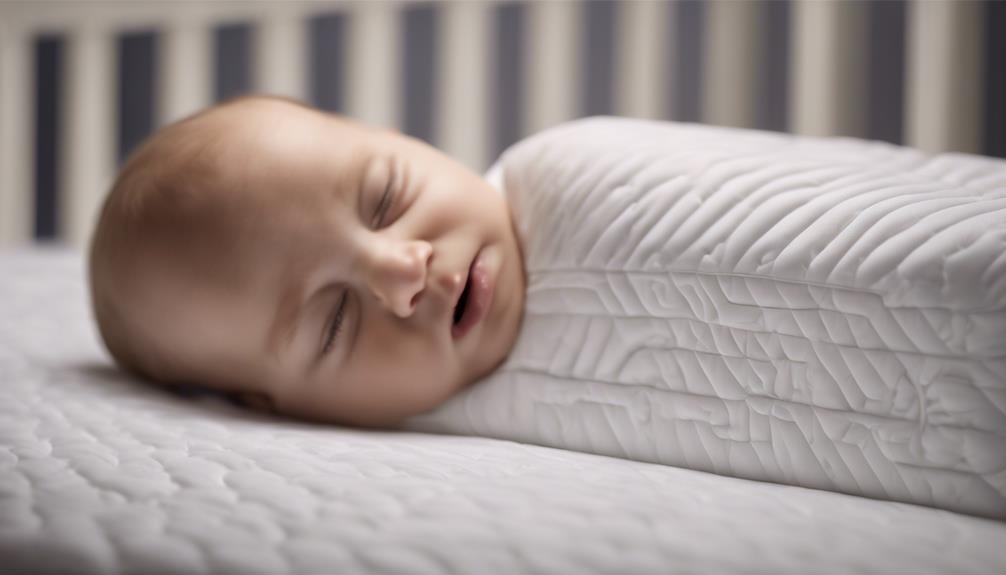
Examining the breathability and temperature regulation features of crib mattress pads highlights their essential role in ensuring a comfortable and safe sleeping environment for babies.
Crib mattress pads crafted with breathable materials facilitate air circulation, preventing overheating and maintaining the best body temperature. These pads are designed to eliminate heat and moisture buildup, creating a cool and cozy sleep experience for infants.
By choosing an ultra-breathable crib mattress pad, parents can provide a comfortable surface that promotes air circulation, enhancing ventilation for better temperature regulation during sleep. Ensuring that the baby sleeps on a breathable surface helps prevent discomfort caused by overheating, offering a restful environment for quality sleep.
The breathability of crib mattress pads plays an important role in creating a conducive atmosphere for the baby's rest, allowing for proper airflow and temperature control throughout the night.
Safety Considerations for Baby's Sleep
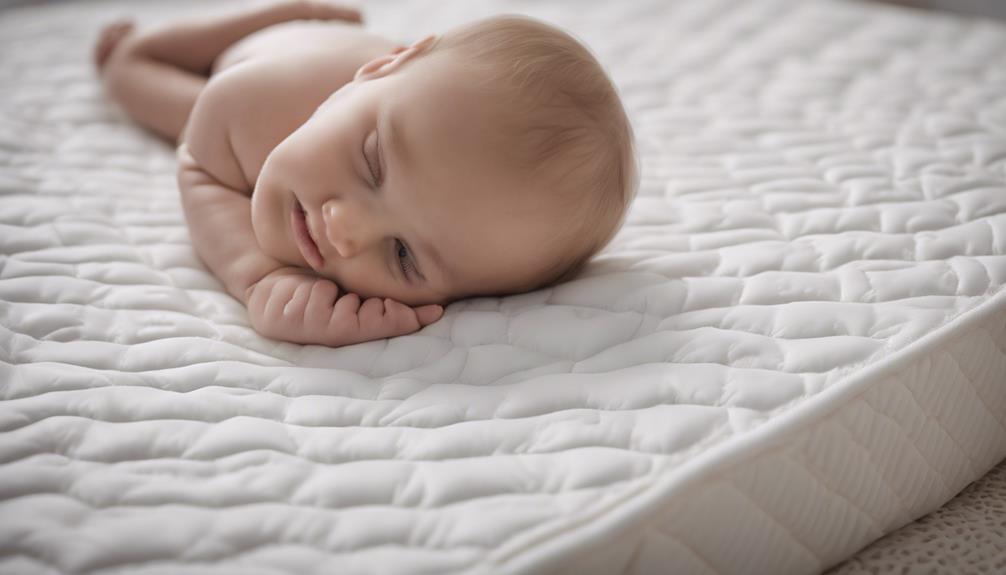
Ensuring a safe sleeping environment for babies involves carefully selecting crib mattress pads that fit securely and are made of breathable, hypoallergenic materials. When it comes to the safety considerations for a baby's sleep, there are key factors to keep in mind:
- Snug Fit: Crib mattress pads should fit snugly without bunching up to align with safety guidelines.
- Breathable Materials: Opt for mattress pads made of breathable and hypoallergenic materials to promote a safe sleep environment.
- Waterproof Protection: Choosing a waterproof crib mattress pad can protect against spills and stains, enhancing the safety of the sleeping area.
- Easy Maintenance: Select a washable crib mattress pad for easy maintenance and cleanliness in the baby's sleep space.
Frequently Asked Questions
What Is the Purpose of a Mattress Pad?
When we talk about mattress pads, we're diving into the world of sleep comfort and protection.
A mattress pad's main purpose is to shield the mattress from spills, stains, and wear, extending its life.
It also enhances the comfort level by adding an extra layer of cushioning.
These pads are like armor for your mattress, ensuring it stays fresh and cozy for a long time.
Can Babies Sleep on a Mattress Pad?
Yes, babies can safely sleep on a crib mattress pad that fits snugly without bunching up. It should be breathable and hypoallergenic for a cozy sleep environment. Plus, it acts as a protective barrier against spills and stains, extending the mattress's life.
Opt for a waterproof pad to maintain hygiene and make clean-up a breeze. So, rest assured, using a crib mattress pad is a smart choice for both comfort and convenience.
Do You Need a Mattress Pad?
We definitely need a mattress pad for our crib! It's a must-have for protecting the mattress from spills and stains, ensuring a comfy and clean sleep environment for our little one.
Having a mattress pad can make cleanup a breeze and reduce the need for frequent mattress washings, saving us time and effort.
It's wise to have a couple of pads on hand so we always have a backup while one is being washed.
Do I Need to Wash a Crib Mattress Pad Before Use?
Yes, it's crucial to wash a new crib mattress pad before using it. This step guarantees cleanliness by removing dust and residues.
We recommend using a gentle, baby-safe detergent to avoid skin irritations. After washing, air dry or tumble dry on a low setting to maintain quality.
Washing the crib mattress pad before use promotes hygiene, eliminates odors, and prepares a cozy sleep environment for your baby.
Conclusion
To sum up, a crib mattress pad is an essential accessory for your baby's comfort and safety during sleep time. By providing a protective layer, enhancing breathability, and regulating temperature, it guarantees a peaceful and restful night for your little one.
Remember to take into account factors like material, waterproofing, and maintenance when selecting the right pad. With the right crib mattress pad, you can create a cozy and secure sleep environment for your baby to thrive.
Mattress Pads
When to Clean Mattress Pad
Nurture your sleep sanctuary by cleaning your mattress pad regularly to ensure a fresh and hygienic resting place.
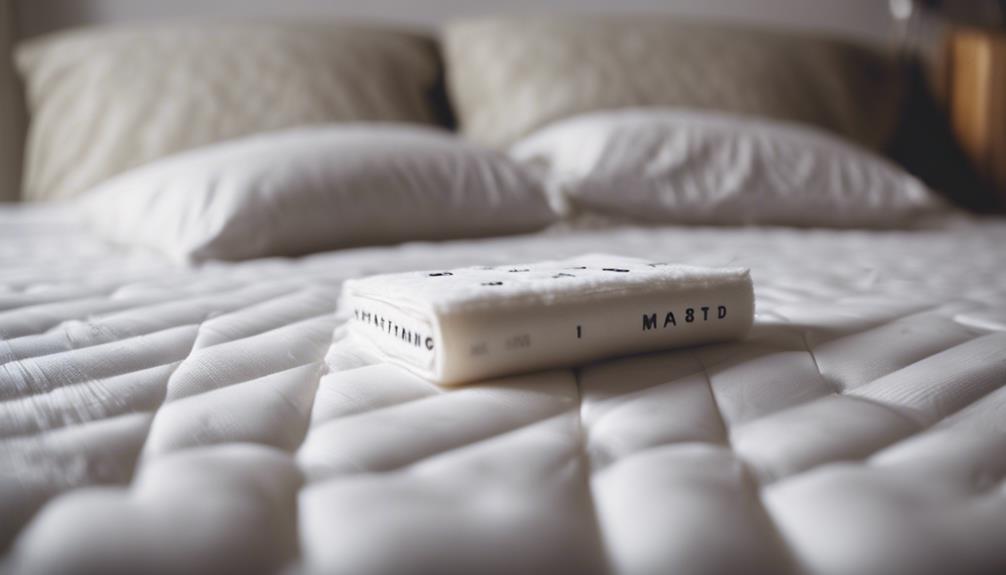
To keep your sleeping sanctuary fresh and clean, be sure to wash your mattress pad every few months. This will help eliminate dust, sweat, dead skin cells, and debris, which in turn will promote bed cleanliness and prolong the lifespan of your mattress. Follow the care label for washing and drying instructions to avoid the growth of mold or mildew. Regular cleaning will prevent allergen buildup, especially from pesky dust mites and pet dander, creating a healthier sleep environment. Cleaning up spills right away will also prevent stains, bacteria, and odors. Additionally, proper care and maintenance will ensure that your pad remains hygienic and fresh. Keeping your mattress pad clean is essential for a restful night’s sleep.
Key Takeaways
- Clean mattress pad every couple of months to remove dust, sweat, and debris.
- Enhances bed cleanliness and prolongs mattress lifespan.
- Follow care label instructions for washing and drying to prevent mold.
- Regular cleaning prevents allergen buildup and dust mites.
- Immediate washing after spills prevents stains, odors, and allergen spread.
Frequency of Cleaning Your Mattress Pad
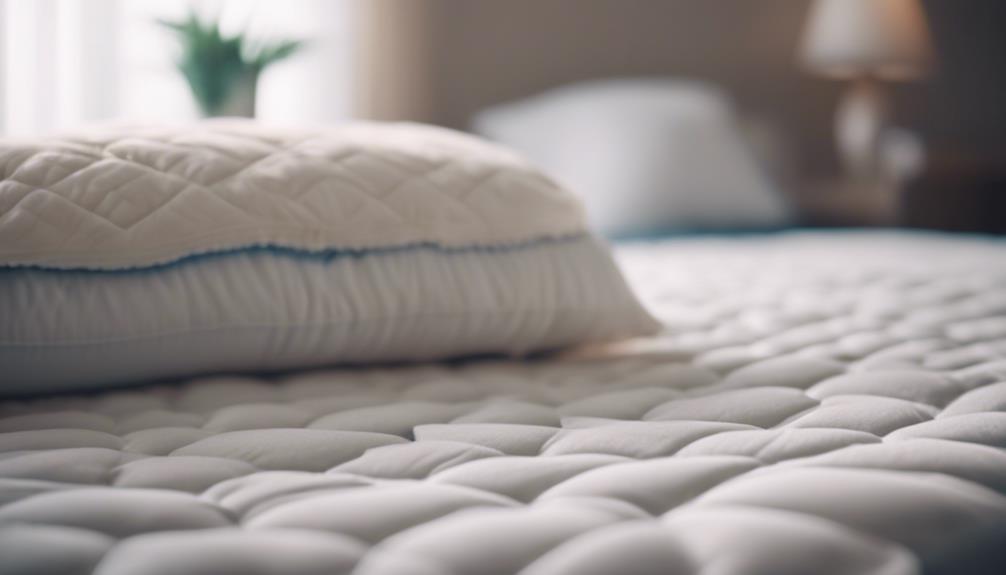
We recommend cleaning your mattress pad every couple of months to guarantee freshness and hygiene. Washing your mattress pad regularly helps to remove dust, sweat, dead skin cells, and other debris that accumulate over time.
A clean mattress pad not only enhances the overall cleanliness of your bed but also prolongs the lifespan of your mattress. To wash your mattress pad, follow the care label instructions for the specific washing and drying recommendations. Use a gentle detergent and wash on a gentle cycle to avoid damaging the pad's fabric or filling.
Make sure to thoroughly dry the mattress pad before putting it back on your bed to prevent mold or mildew growth. Remember that immediate washing is necessary for spills, stains, or stretching issues to prevent them from setting and becoming more challenging to clean later.
Allergies and Pets Consideration

If you suffer from allergies or have pets at home, it's important to take into account how they can affect the cleanliness of your mattress pad. Allergens like dust and pet dander can accumulate on the pad, potentially worsening allergy symptoms.
Allergy Prevention Tips
When should allergy sufferers and pet owners consider increasing the frequency of washing their mattress pads? Allergy prevention tips suggest that regular cleaning is important to prevent allergen buildup.
Dust mites, a common trigger for allergies, can be eliminated through washing the mattress pad more often. Pet owners, in particular, should pay attention to washing instructions as pet dander and hair accumulation can worsen allergy symptoms.
By following specific care guidelines, allergy issues can be minimized, creating a cleaner sleeping environment. Maintaining a routine of washing the mattress pad not only helps in reducing allergens but also guarantees the mattress pad remains in good condition.
Taking these steps can make a significant difference in managing allergies and promoting better sleep quality.
Pet-Friendly Maintenance
Considering the potential introduction of allergens by pets, maintaining a clean mattress pad is essential for allergy sufferers and pet owners alike. Pet dander and fur can accumulate on the mattress pad, leading to discomfort for sensitive individuals. To combat this, it's advisable to wash the mattress pad every month, especially if pets frequently sleep on the bed. This pet-friendly maintenance routine helps reduce exposure to allergens and guarantees a fresh sleeping environment. By staying on top of cleaning, allergy sufferers can minimize the impact of pet-related allergens and improve their overall sleep quality. Here's a helpful table to summarize the key points:
| Key Points | Details |
|---|---|
| Wash Frequency | Monthly washing is recommended for mattress pads with frequent pet contact. |
| Allergy Prevention | Regular cleaning helps remove pet dander and allergens, reducing the risk of allergies. |
| Odor Control | Cleaning the mattress pad regularly can help eliminate pet-related odors for freshness. |
Immediate Washing After Spills

After a spill occurs on a mattress pad, immediate washing is crucial to prevent stains and maintain cleanliness. Washing the mattress pad promptly after spills not only prevents stains from setting in but also helps in warding off the growth of bacteria and mold. This quick action guarantees that the bedding remains fresh and free from unpleasant odors.
Additionally, cleaning spills promptly can stop allergens and dust mites from spreading, promoting a healthier sleeping environment. By washing the mattress pad right after spills, you're actively maintaining its hygiene and reducing potential health hazards associated with an unclean sleeping surface.
Care Label Instructions Importance
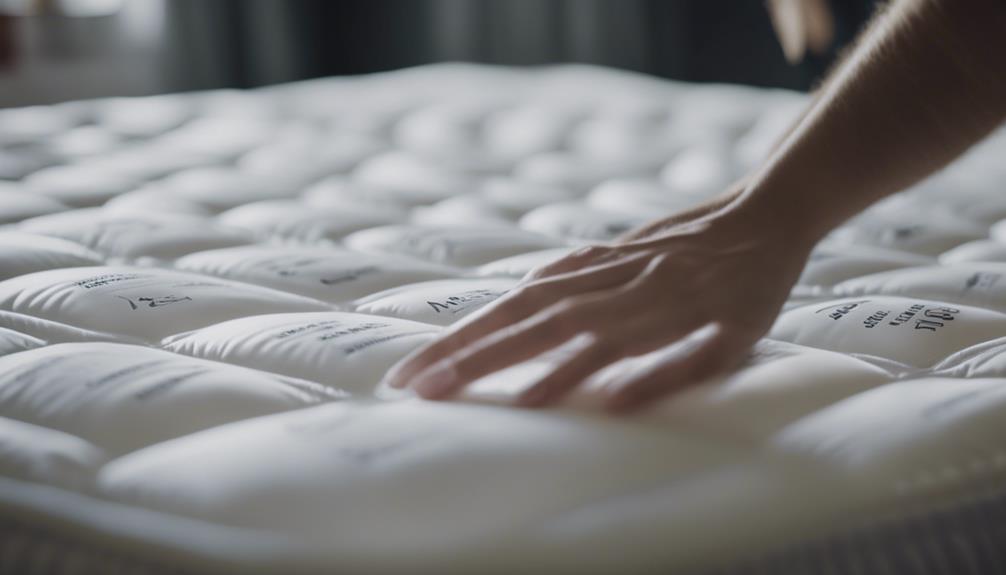
Care label instructions are essential for keeping your mattress pad in top condition. They provide clear guidelines on how to wash and care for your pad properly.
Label Care Tips
Following the care label instructions is vital for maintaining the quality and longevity of your mattress pad. When it's time to wash your mattress pad or mattress protector every few months, it's essential to follow the instructions provided on the care label.
Here are some label care tips to make sure you're properly caring for your mattress pad:
- Wash on a gentle cycle: Protect the fabric and materials by using a gentle washing cycle.
- Use mild detergent: Opt for a mild detergent to prevent damage to the pad.
- Avoid high heat: Follow temperature guidelines to prevent shrinking or weakening of the materials.
- Air dry or tumble low: Choose the appropriate drying method to maintain the pad's integrity.
- Check for specific instructions: Care labels may provide unique details tailored to your mattress pad.
Maintenance Frequency
We prioritize adhering to the care label instructions to maintain the cleanliness and durability of our mattress pad. Following the recommended washing frequency on the care label is vital in preserving the quality and effectiveness of the mattress pad.
Most care labels suggest cleaning the mattress pad every couple of months to prevent damage and guarantee longevity. However, exceptions may apply for those with allergies or pets, necessitating more frequent washing.
It's essential to spot-clean spills, stains, or visible dirt promptly to keep the mattress pad hygienic. By consistently following the care instructions and washing frequency guidelines, we can make sure that our mattress pad remains in top condition for a long time.
Prolonging Mattress Pad Lifespan
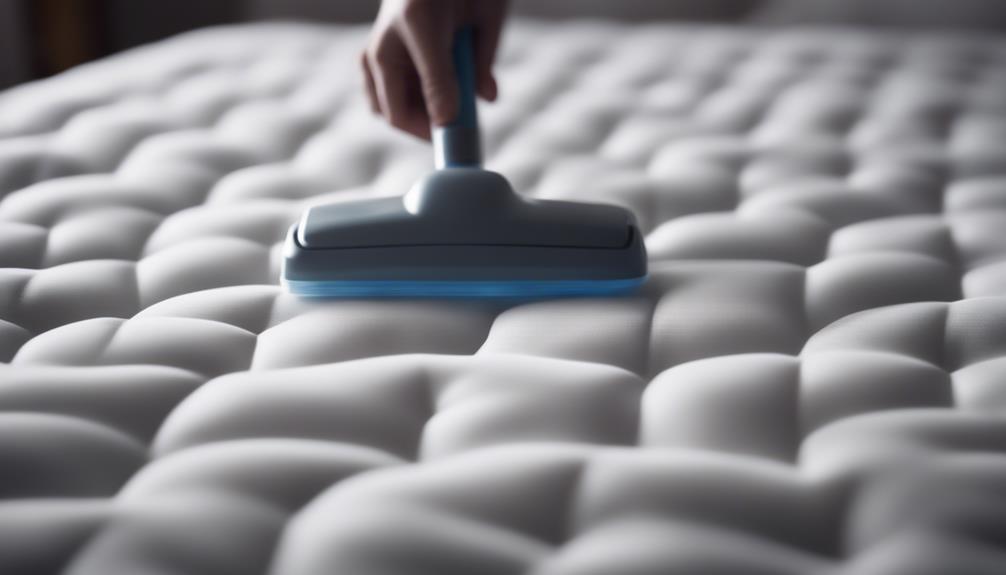
To extend the life of your mattress pad, regularly washing it every couple of months is crucial. Keeping your mattress pad clean not only guarantees a fresh sleeping environment but also helps protect your mattress from wear and tear.
Here are some tips to maximize the life of your mattress pad:
- Regular Cleaning: Wash your mattress protector every couple of months to prevent the buildup of dirt, sweat, and allergens.
- Follow Care Instructions: Adhere to specific care instructions provided by the manufacturer to maintain the quality and durability of your mattress pad.
- Protect Your Mattress: A clean mattress pad acts as a barrier, shielding your mattress from spills, stains, and bacteria.
- Prevent Yellowing: Regular washing can prevent yellowing and discoloration, keeping your mattress pad looking fresh for longer.
- Enhance Longevity: By cleaning your mattress pad frequently, you can extend the lifespan of both the pad and your mattress, ensuring a comfortable and hygienic sleep environment.
Enhancing Sleep Quality
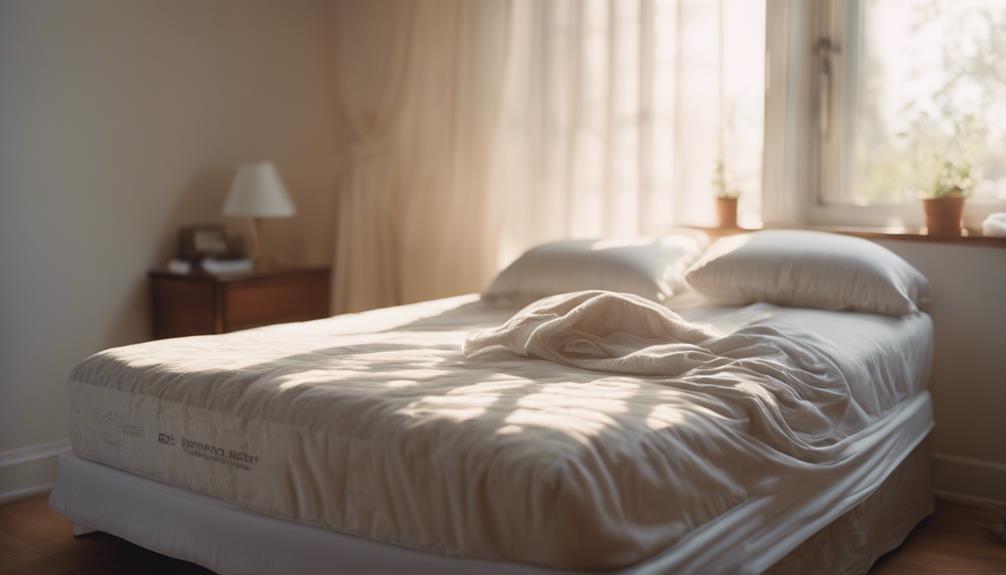
Regular cleaning of your mattress pad not only guarantees a fresh and hygienic sleeping environment but also plays a significant role in enhancing the quality of your sleep. Washing your mattress pad every couple of months can help maintain its freshness and cleanliness, ensuring that you have a comfortable and healthy place to rest each night. By following the care label instructions for washing, you can optimize the performance and longevity of your mattress pad, ultimately contributing to better sleep quality.
Taking care of spills or stains promptly by washing them immediately can also help in creating a more hygienic sleep environment, which is essential for a good night's sleep. Regular cleaning prevents issues such as odor, dust mites, and allergens from building up, which could otherwise impact your sleep comfort. By maintaining a clean mattress pad, you reduce exposure to bacteria, allergens, and even prevent yellowing of sheets, promoting better sleep hygiene overall. Remember, a well-cared-for mattress pad can make a significant difference in the quality of your sleep.
Preventing Buildup of Body Oils
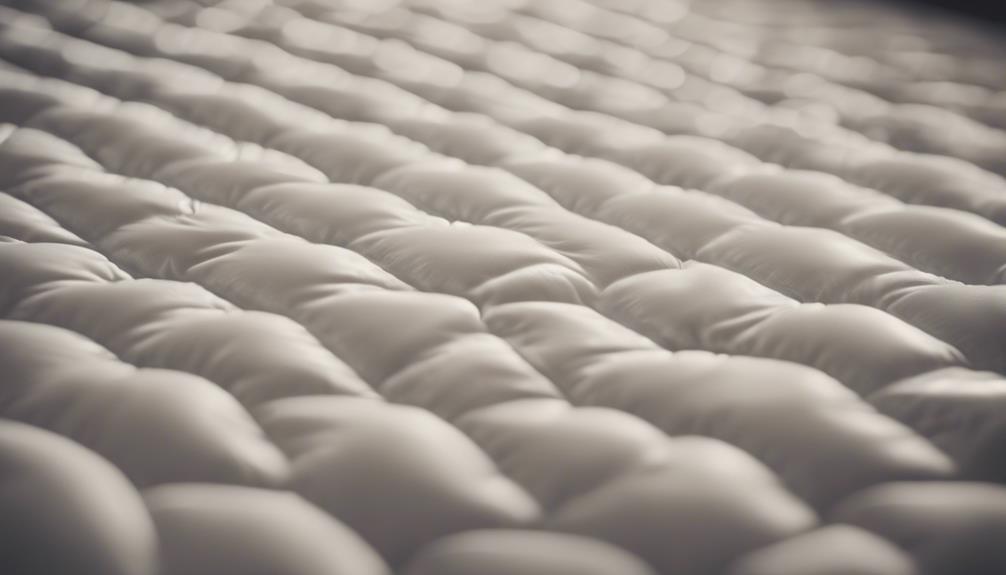
To prevent the buildup of body oils on your mattress pad, guaranteeing a fresh and hygienic sleep environment, regular washing is essential. Body oils can accumulate over time, attracting dust mites and causing unpleasant odors. Here are some tips to help you maintain your mattress pad and extend its lifespan:
- Regular Washing: Washing your mattress pad every couple of months can help prevent the accumulation of body oils and maintain freshness.
- Prevent Buildup: By keeping up with regular washing, you can prevent body oils from causing yellow stains on the mattress pad.
- Extend Lifespan: Proper care and maintenance, including washing to remove body oils, can extend the lifespan of your mattress pad.
- Improve Sleep Hygiene: Removing body oils through washing contributes to a cleaner sleep environment, promoting better sleep hygiene.
- Overall Freshness: Regular washing of your mattress pad not only prevents body oil buildup but also ensures an overall fresh and clean sleeping surface.
Dust and Allergen Removal
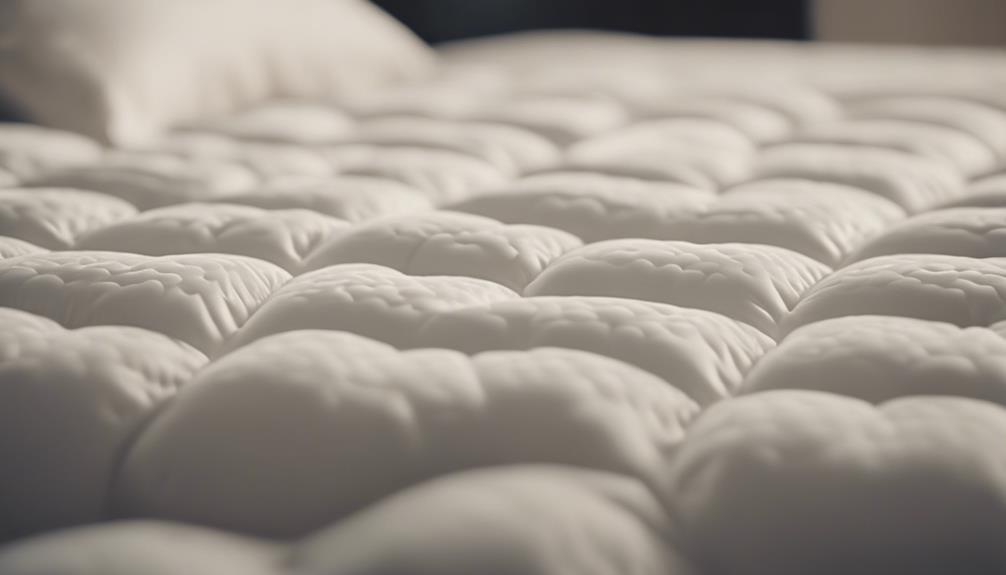
Maintaining a clean mattress pad not only prevents body oil buildup but also plays an essential role in removing dust and allergens for a healthier sleep environment. Dust mites are tiny creatures that thrive in mattresses and bedding, feeding on dead skin cells and causing allergic reactions in some individuals. Regular cleaning of mattress pads is important to eliminate these dust mites and allergens, promoting better air quality and reducing the risk of allergies. Vacuuming your mattress pad periodically can help to remove dust and dirt, while washing it every few months can provide a more thorough cleaning to keep allergens at bay. Check out the table below for a quick overview of how cleaning and vacuuming your mattress pad can contribute to a healthier sleep environment:
| Benefits of Cleaning Mattress Pads |
|---|
| Removes dust mites |
| Reduces allergens |
| Improves air quality |
| Enhances sleep comfort |
Washing Frequency for Tough Stains
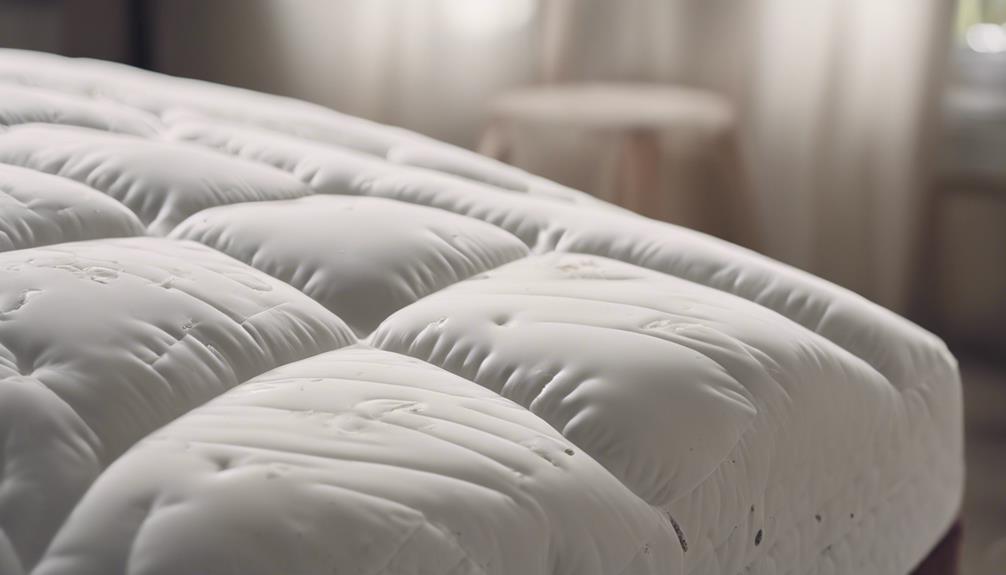
When dealing with tough stains on a mattress pad, it's important to act promptly to prevent them from becoming permanent. Using a stain remover that matches the type of stain is essential for effective removal.
Following the manufacturer's care instructions and spot cleaning before washing can help maintain the pad's appearance and functionality.
Stain Removal Techniques
Addressing tough stains on mattress pads requires prompt treatment to prevent them from setting and becoming harder to remove. When dealing with stubborn stains, it's crucial to use the right techniques to guarantee effective cleaning without damaging the fabric.
Here are some tips for removing tough stains from your mattress pad:
- Use a mild detergent and cold water for gentle stain removal.
- Apply a mixture of water and enzyme cleaner for specific stains like blood or urine.
- Avoid hot water or harsh chemicals to prevent setting the stain.
- Always follow the care label on the mattress pad for specific instructions.
- Act quickly to tackle tough stains before they become more challenging to remove.
Recommended Cleaning Products
To effectively tackle tough stains on your mattress pad, consider utilizing OxiClean Laundry Stain Remover Spray for efficient removal. This versatile product is easy to use and works well with various fabric types, offering targeted treatment for stubborn stains. OxiClean's spray application makes it convenient to apply directly to the affected area on your mattress pad, ensuring effective stain removal. Additionally, this affordable stain remover can be paired with household items like vinegar and lemon juice for enhanced cleaning power. By incorporating OxiClean Laundry Stain Remover Spray into your cleaning routine, you can maintain the cleanliness of your mattress pad with ease.
| Features | Benefits |
|---|---|
| Easy to use | Convenient application for targeted treatment |
| Works on various fabric types | Versatile cleaning solution |
| Affordable | Cost-effective stain removal option |
| Compatible with household items | Enhanced cleaning power |
| Spray application | Easy and efficient stain removal |
Prevention of Future Stains
Increasing the frequency of washing tough stains on your mattress pad helps maintain its appearance and hygiene while preventing stains from setting in. When dealing with tough stains, such as bodily fluids or rust, it's important to act promptly to avoid yellowing and deterioration.
Here are some tips to prevent future stains on your mattress pad:
- Address stains promptly to prevent setting.
- Use specific care instructions for effective stain removal.
- Increase washing frequency for tough stains.
- Regular cleaning helps maintain appearance and hygiene.
- Following care instructions extends the pad's lifespan.
Hygienic Sleeping Environment
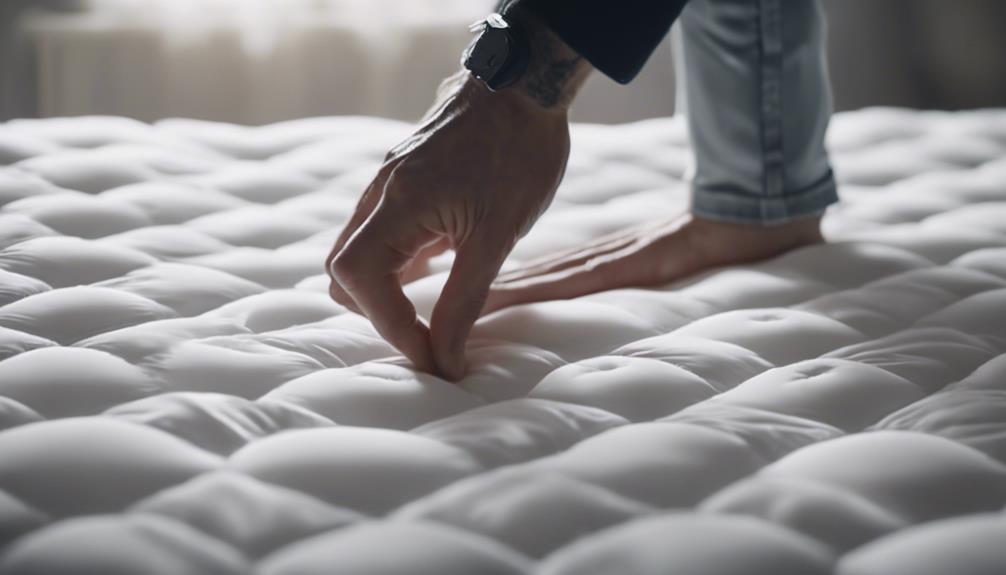
Maintaining a hygienic sleeping environment involves cleaning your mattress pad every couple of months. Depending on factors like allergies, pets, or spills, you may need to clean it more frequently. Regular washing not only helps prevent yellowing and stains but also stops the buildup of allergens and bacteria. Follow the care label instructions, typically recommending washing in warm water and drying on a low setting. By keeping a clean mattress pad, you enhance the longevity of your mattress, promote better sleep hygiene, and increase overall comfort. To help you understand the importance of this practice, we've provided a table below outlining key points related to maintaining a hygienic sleeping environment.
| Aspect | Importance | Example |
|---|---|---|
| Washing Frequency | Regular cleaning prevents allergen and bacteria buildup | People with allergies may need more frequent cleaning |
| Care Label Instructions | Following instructions ensures proper maintenance | Washing in warm water and low-heat drying |
| Benefits | Enhances mattress longevity and overall sleep hygiene | Prevents yellowing, stains, and discomfort |
| Impact | Affects sleep quality and overall well-being | Clean bedding promotes better rest and health |
Frequently Asked Questions
How Often Should I Clean My Mattress Pad?
We should clean our mattress pad regularly to maintain hygiene and freshness. For those with allergies or pets, more frequent washing may be necessary to prevent allergen buildup.
Immediate action is important for spills or visible dirt on the pad. Weekly washing might be needed for heavy sweaters or those with specific cleanliness needs.
Follow care label instructions, use mild detergent, and air dry or tumble dry on low heat for proper maintenance.
When Should I Wash My Mattress Topper?
We wash our mattress topper every 1-2 months to maintain freshness and hygiene. Regular washing helps guarantee issues like odors, dust mites, and stains. Following care label instructions assures proper maintenance.
For heavy sweaters or allergy sufferers, more frequent washing may be necessary. Washing the mattress topper before first use helps remove chemicals and prepares it for ultimate comfort.
Keeping our sleeping environment clean is vital for a restful night's sleep.
When Should I Wash My Mattress Cover?
Maintaining a clean mattress cover is crucial for a comfortable and healthy sleep environment.
We wash our mattress cover every 1-2 months for freshness and cleanliness. Those who sweat heavily should do so every 2-4 weeks to avoid odors.
Allergy sufferers might need more frequent washes to reduce allergens. Washing the mattress cover before first use removes chemicals.
Regular washing prevents dust mites and extends its lifespan. Keeping a clean cover is vital for a comfortable and healthy sleep environment.
Do Mattress Pads Need to Be Washed Before Use?
Yes, mattress pads should be washed before use. It's important to remove any chemicals or residues from manufacturing that might cause skin irritation or allergies. This step guarantees a fresh and clean sleeping surface, improving comfort and safety.
Following care instructions and washing before use will maintain the pad's quality and longevity. By washing a new mattress pad, we prioritize our health and sleep quality.
Conclusion
To sum up, maintaining your mattress pad clean is crucial for a sanitary sleeping environment. Remember, a stitch in time saves nine – regular washing can prevent tough stains and prolong the lifespan of your mattress pad.
By following care label instructions, washing immediately after spills, and removing dust and allergens regularly, you can guarantee a comfortable and healthy place to rest your head each night.
Stay on top of cleaning to enjoy a fresh and cozy bed for years to come.
Mattress Pads
Do Mattress Pads Wear Out
Need to know if mattress pads wear out? Discover signs, lifespan factors, and maintenance tips to ensure a comfortable sleep surface.
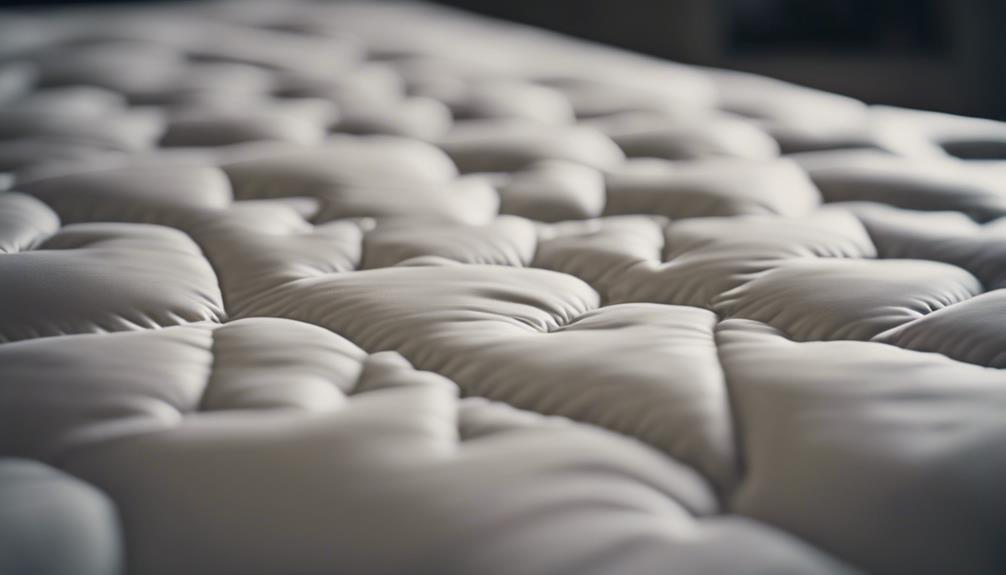
Yes, mattress pads do wear out over time. Factors such as material quality, care habits, and usage frequency influence their lifespan, typically lasting 1 to 2 years. Signs like thinning fabric or decreased comfort indicate a need for replacement. To extend longevity, rotate pads regularly, follow care instructions, and consider using a mattress protector. Proper washing with mild detergents and occasional flipping can help maintain shape and support. Monitoring for persistent stains, odors, and comfort issues promotes better sleep quality. Be mindful of these indicators for a refreshed sleep surface.
Key Takeaways
- Average lifespan of 1 to 2 years, influenced by material quality and care.
- Signs of wear like thinning fabric indicate replacement is needed.
- Material quality and washing frequency impact longevity.
- Proper care, mild detergents, and following instructions enhance durability.
- Rotating, flipping, and regular cleaning extend the lifespan.
Average Lifespan of Mattress Pads
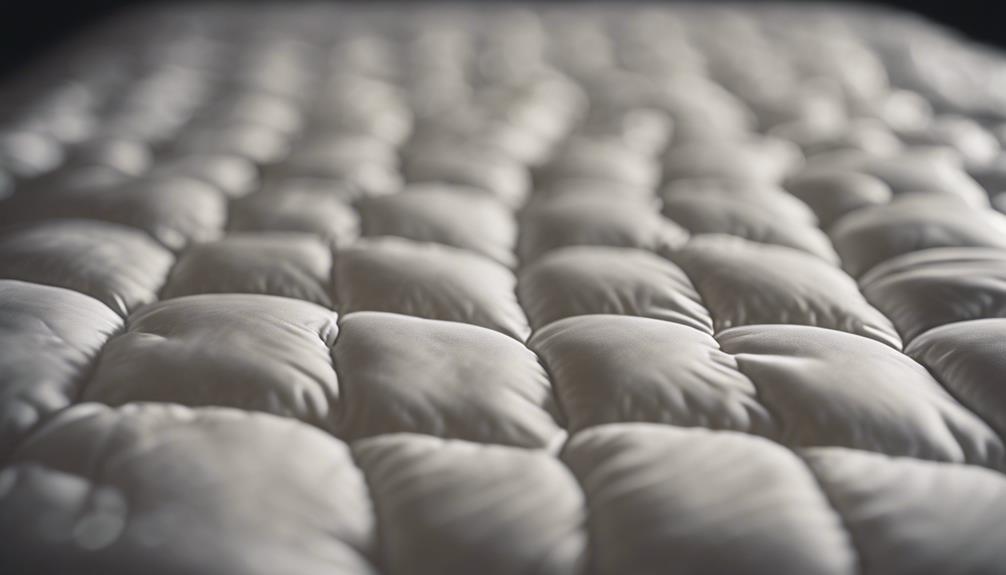
Mattress pads typically last an average of 1 to 2 years, with factors such as material quality and care affecting their longevity. The lifespan of mattress pads can vary based on the frequency of use.
Pads used daily will wear out faster compared to those used occasionally for guests or seasonal changes. Quality materials like memory foam tend to have a longer lifespan than basic polyester pads due to their durability and resilience.
Proper care, such as regular washing and following care instructions, can greatly extend the lifespan of a mattress pad. Noticing signs of wear, such as thinning fabric, stains, or decreased comfort, is essential as they indicate the need for replacement.
Factors Contributing to Mattress Pad Wear
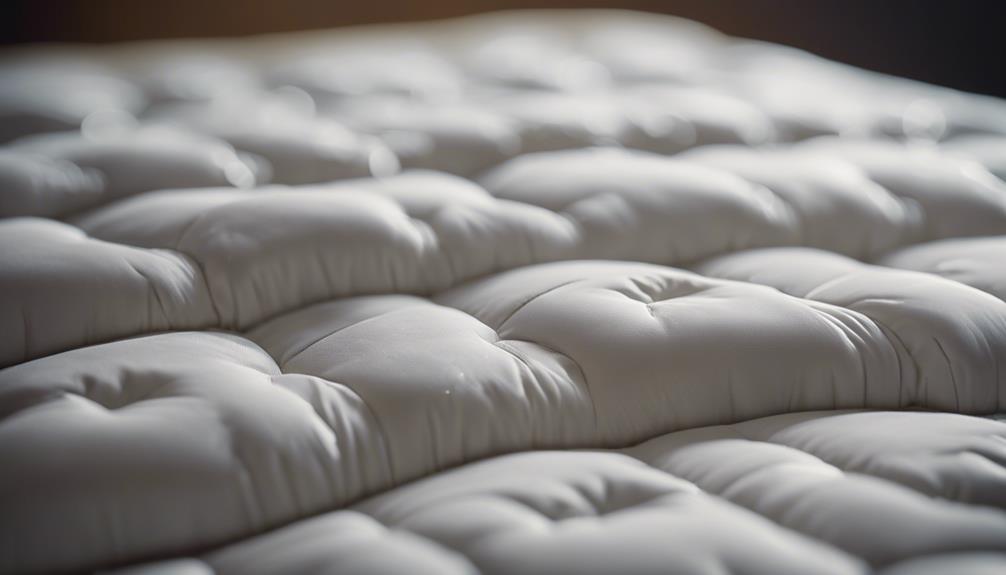
When it comes to the factors that contribute to mattress pad wear, the quality of materials used and how often we use them are key players.
The type of fabric and the frequency of washing play roles in how quickly a pad deteriorates.
We should also consider environmental factors like pets, food spillage, and perspiration, all of which can impact the longevity of our mattress pads.
Material Quality
Choosing a mattress pad made from top-quality materials greatly influences its durability and wear resistance. High-quality materials like memory foam or latex can greatly extend the lifespan of a mattress pad. Factors such as durability, resilience, thickness, density, and construction quality all play an important role in determining how long a mattress pad will last. Inferior materials may wear out quicker, leading to a shorter lifespan for the pad. By opting for a pad made from premium materials, you can guarantee a more durable and long-lasting product. Here's a table to help you understand how material quality impacts mattress pad wear:
| Material Quality | Impact on Wear Resistance |
|---|---|
| High-quality materials (e.g., memory foam, latex) | Longer lifespan |
| Durability and resilience | Better withstand daily use |
| Thickness and density | Affect longevity of the pad |
| Construction quality | Influences durability |
Frequency of Use
Considering the impact of frequency of use on mattress pad wear, the regularity of usage directly influences the longevity and durability of the pad. High-frequency use, like daily sleeping or intense activities on the bed, accelerates the wear and tear, leading to quicker deterioration of the pad's material and structure.
Conversely, infrequent use or placing the pad on secondary beds may result in less wear, ultimately extending its lifespan. To gauge the longevity of a mattress pad, it's essential to analyze usage patterns and adjust expectations accordingly.
Understanding how often and under what circumstances the pad is used provides valuable insights into its expected durability. By recognizing the effects of frequency of use, one can make informed decisions to maintain the pad's quality over time.
Impact of Washing on Mattress Pads
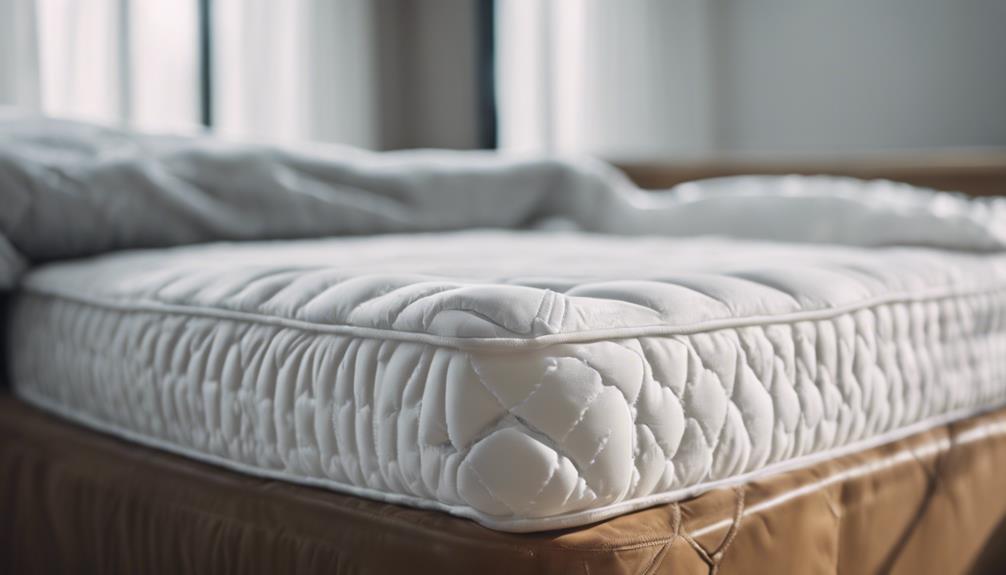
Frequent washing of mattress pads can accelerate wear and tear on the fabric and padding, leading to reduced longevity and effectiveness. Overwashing can result in premature fabric thinning and loss of padding, diminishing the overall quality of the pad. To maintain the lifespan of your mattress pad, it's important to follow the manufacturer's care instructions for washing.
Utilizing gentle cycles, mild detergents, and appropriate drying techniques can help minimize the negative impact of washing on the pad. Proper care during washing, such as avoiding high heat settings and harsh chemicals, is essential for extending the longevity of mattress pads.
Signs of Worn-Out Mattress Pads

Thinning fabric, holes, or frayed edges serve as clear indicators that a mattress pad has reached the end of its lifespan. When these signs start appearing, it's time to contemplate a replacement.
Not only do these issues affect the appearance of the mattress pad, but they can also impact its comfort and support levels. A worn-out mattress pad may no longer provide the cushioning and protection your mattress needs.
Additionally, persistent stains and odors that refuse to budge even after washing are signals that it's time for a new mattress pad. These stains and odors can harbor allergens, affecting both your health and the quality of your sleep.
If you find yourself tossing and turning more at night or waking up with aches and pains, your mattress pad might be the culprit. Being attentive to these signs of a worn-out mattress pad ensures you can maintain a comfortable and supportive sleep environment.
Maintaining Mattress Pads for Longevity
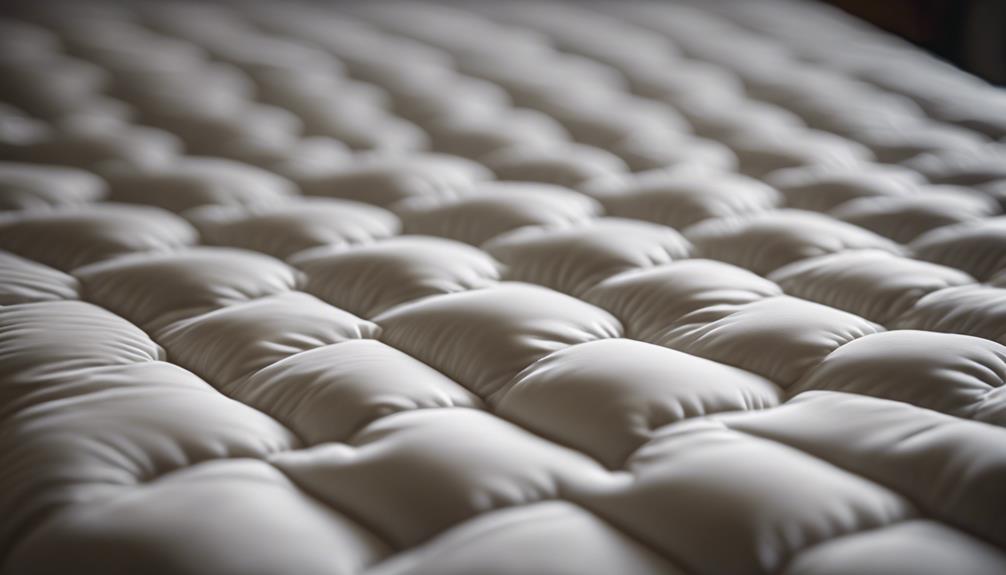
Let's talk about how to keep your mattress pad in top shape for longer use.
Regularly washing it according to the manufacturer's instructions can help maintain its freshness and extend its lifespan.
Additionally, flipping and rotating the pad can guarantee even wear, prolonging its durability.
Washing for Freshness
Regularly washing your mattress pad every 1-3 months is essential for maintaining its freshness and longevity. Following care instructions is vital to extend the pad's lifespan and promote proper hygiene.
Dirt, sweat, and allergens can accumulate over time, affecting the pad's condition and your sleep quality. By washing your mattress pad regularly, you can remove these contaminants, preventing premature deterioration and creating a cleaner sleep environment.
Freshly washed mattress pads contribute to better sleep comfort, making your bed a cozy sanctuary. Remember, proper cleaning not only keeps your mattress pad fresh but also helps you enjoy a healthier and more hygienic sleeping experience.
Flipping for Evenness
How can flipping and rotating your mattress pad regularly help maintain its longevity and comfort?
Regularly flipping and rotating your mattress pad is crucial to distribute wear evenly, preventing premature deterioration and extending its lifespan.
By flipping the pad every few months, you can help maintain its shape and support.
Additionally, rotating the pad ensures that all areas receive equal pressure, reducing the risk of lumps or sagging.
Consistent flipping and rotating not only help extend the pad's lifespan but also maintain a fresh feel, ultimately improving sleep quality.
Making these simple adjustments to your mattress pad maintenance routine can go a long way in securing its durability and enhancing your overall sleep experience.
Benefits of Using a Mattress Protector

Using a mattress protector provides numerous benefits for maintaining the cleanliness and longevity of your mattress. A mattress protector acts as a shield, helping to prevent stains, spills, and damage that can occur over time.
By creating a barrier against dust mites, allergens, and even bed bugs, it guarantees a cleaner sleeping environment for you and your family. Additionally, using a mattress protector can extend the lifespan of your mattress by reducing wear and tear caused by everyday use.
For added protection, waterproof mattress protectors are available to guard against liquid spills and accidents, ultimately preserving the integrity of your mattress. Some mattress protectors even come with temperature-regulating features, offering a cool and comfortable sleep experience.
The benefits of using a mattress protector go beyond just protection; they contribute to a healthier and more durable mattress, ensuring a good night's sleep for years to come.
Rotating Mattress Pads for Durability
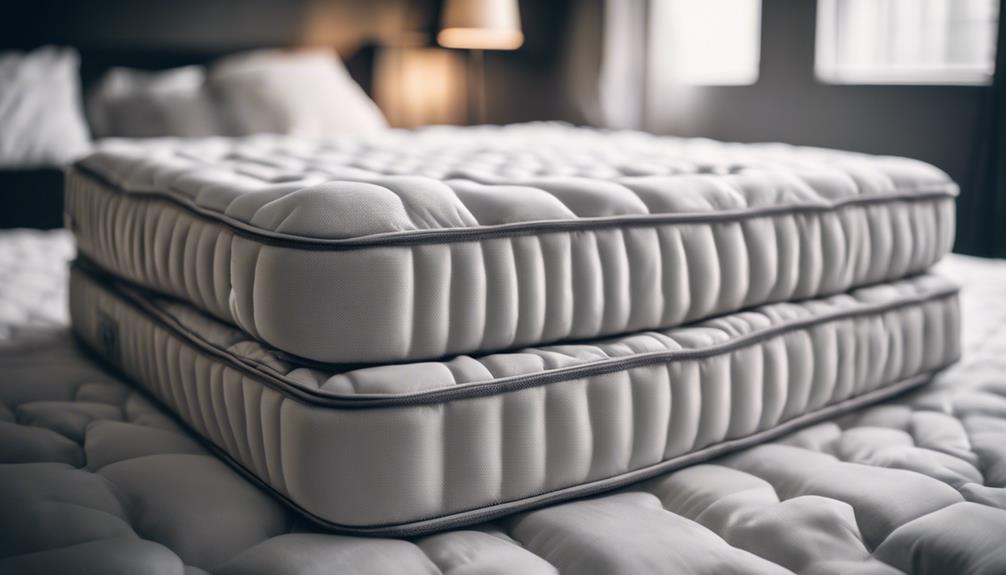
To maintain the durability of mattress pads, it's important to regularly rotate them to evenly distribute wear and tear. By rotating the mattress pad every 3-6 months, you can prevent permanent indentations from forming in specific areas. This simple practice can greatly extend the lifespan of your mattress pad and help maintain its comfort level over time.
When you rotate your mattress pad, you guarantee that the wear and tear is distributed evenly across its surface. This prevents certain areas from experiencing more pressure than others, which can lead to premature deterioration. Regularly flipping and rotating the pad will help it maintain its shape, support, and overall quality.
Extending Mattress Pad Lifespan

Regularly rotating and flipping your mattress pad is vital for ensuring its longevity and maintaining peak comfort. By following the manufacturer's care instructions, you can extend the lifespan of your mattress pad. Proper care, such as washing and drying according to guidelines, is essential in preventing premature deterioration. Incorporating these maintenance practices not only helps in extending the lifespan of the mattress pad but also guarantees excellent comfort for a longer period.
Using a mattress protector can shield the pad from spills, stains, and wear, further enhancing its durability. Rotating and flipping the mattress pad regularly promotes even weight distribution, reducing wear and tear over time. Regular cleaning and care play a significant role in preventing deterioration and maximizing the lifespan of your mattress pad. By adopting these simple yet effective measures, you can enjoy a comfortable and long-lasting mattress pad experience.
How to Clean Mattress Pads Effectively
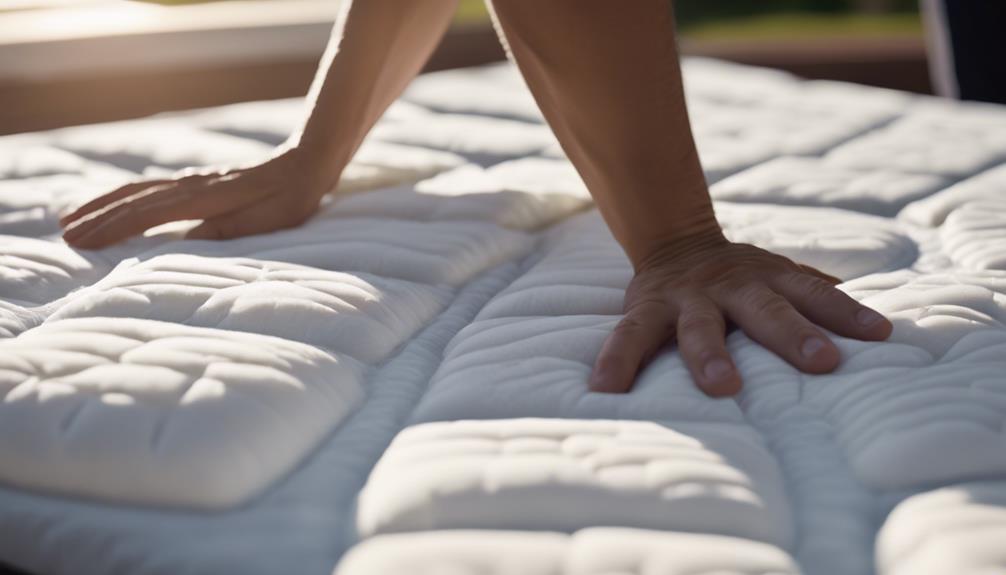
In maintaining the freshness and hygiene of your mattress pad, it's recommended to clean it every 3 months. To clean your mattress pad effectively, follow these steps:
- Check Washing Instructions: Always follow the manufacturer's instructions to guarantee compatibility with your washing machine and avoid damaging the pad.
- Use Gentle Cycles: For machine-washable pads, opt for gentle cycles to prevent wear and tear.
- Air Dry or Tumble Dry: After washing, either air dry the pad or tumble dry it on low heat to maintain its quality.
- Spot Clean with Mild Detergent: If your pad isn't machine washable, spot clean it using a damp cloth and a mild detergent.
- Regular Cleaning for Longer Lifespan: By cleaning your mattress pad regularly, you can prevent premature wear and extend its lifespan.
When to Replace Your Mattress Pad
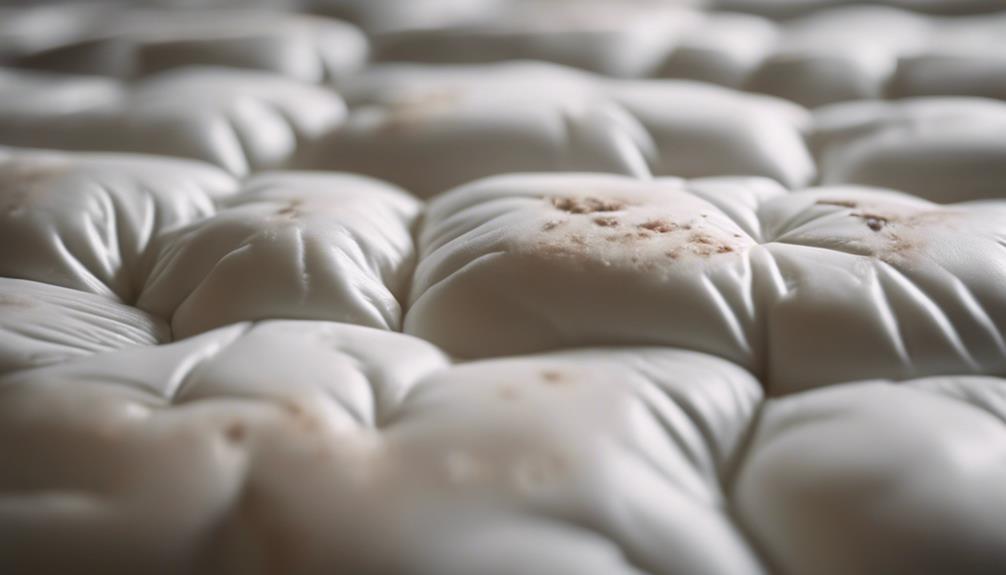
When considering when to replace your mattress pad, it's important to pay attention to signs of wear like thinning fabric, persistent stains, or decreased comfort levels.
Not only does changing the pad regularly enhance hygiene concerns, but it also guarantees a better night's sleep by preventing allergens and maintaining a clean sleep environment.
Monitoring for these signs and replacing the mattress pad in a timely manner can greatly improve your overall sleep quality.
Signs of Wear
Our mattress pad may need replacing if we notice thinning fabric, holes, or frayed edges compromising its protective function. Here are some signs that indicate it's time to replace your old mattress pad:
- Persistent stains and odors that resist washing out
- Accumulation of allergens impacting sleep environment
- Decreased comfort and support over time
- Maintenance of a clean sleep environment
- Improved overall sleep quality
Regularly changing your mattress pad not only guarantees a hygienic sleep environment but also helps in reducing allergens and enhancing your sleep quality. By being attentive to these signs of wear, you can maintain a comfortable and healthy sleep space.
Hygiene Concerns
Regularly checking the condition of your mattress pad guarantees a clean and healthy sleep environment. When stains, odors, or allergen accumulation become persistent, it's time to replace your mattress pad. Thinning fabric, holes, or frayed edges compromise the pad's hygiene and performance. These signs indicate that your mattress pad is no longer providing the protection you need.
Comfort Deterioration
Inspecting for signs of wear on your mattress pad is essential to ensuring exceptional comfort and sleep quality. Over time, mattress pads wear out, leading to comfort deterioration that can affect your sleep. Look out for decreased cushioning, support, and comfort, as well as body impressions, lumps, or sagging.
These are clear indicators that it's time to replace your mattress pad to avoid body aches, stiffness, and poor sleep. By regularly changing your mattress pad, you can refresh your sleep surface and enhance overall comfort for a rejuvenating night's rest.
Frequently Asked Questions
How Often Should You Replace a Mattress Pad?
When it comes to replacing a mattress pad, it's important to take into account factors like usage, material quality, and care practices.
Typically, experts recommend swapping out your mattress pad every 1-2 years for best performance. However, this timeframe can vary based on individual circumstances.
Signs that it may be time for a change include thinning fabric, persistent stains, odors, and decreased comfort.
Regularly updating your mattress pad helps maintain a clean sleep environment and enhances your overall sleep quality.
How Long Should a Mattress Pad Last?
Mattress pads typically last 2-3 years with regular use, but higher quality ones can endure up to 5 years. Factors like usage frequency, maintenance, and material quality affect longevity.
Signs of wear include thinning fabric, loss of support, and decreased comfort. Rotating and flipping the pad regularly can help distribute wear and extend its lifespan.
It's crucial to take into account these factors to maximize the longevity of your mattress pad.
What Is the Lifespan of a Mattress Protector?
The lifespan of a mattress protector typically ranges from 2 to 5 years. Factors like material quality and care impact longevity. High-quality protectors made of durable materials can last over 5 years.
Regular cleaning and proper maintenance can extend its life. Signs of wear include tears, leaks, stains that persist, and reduced effectiveness.
Following care instructions diligently can help maintain the protector's condition and protect your mattress for years.
Do Memory Foam Pads Wear Out?
Memory foam pads do wear out over time due to regular use and body weight. Signs of wear include loss of support, reduced comfort, and indentations in the foam.
The average lifespan is around 3-5 years, depending on usage. Factors like material quality, maintenance, and rotation frequency impact wear.
Using a mattress protector and regular cleaning can help extend the pad's lifespan. Proper care is key to maximizing durability.
Conclusion
To sum up, just like any other household item, mattress pads do wear out over time due to factors like usage and washing.
It's important to keep an eye out for signs of wear and tear, such as lumps or tears, to guarantee a comfortable and supportive sleep surface.
By rotating and cleaning your mattress pad regularly, you can extend its lifespan and enjoy a cozy night's rest for years to come.
Remember, a well-maintained mattress pad is the key to a good night's sleep.
-
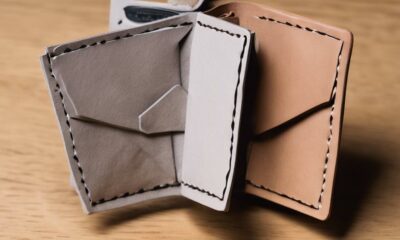
 Vetted6 months ago
Vetted6 months ago14 Best Personalized Father's Day Gifts for Your Husband – Show Him You Care
-

 Alfresco6 months ago
Alfresco6 months agoAlfresco Stacker Doors: Seamless Indoor-Outdoor Living!
-
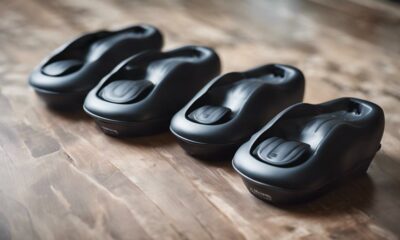
 Vetted7 months ago
Vetted7 months ago15 Best EMS Foot Massagers for Neuropathy to Soothe Your Feet
-

 Craft and Textiles7 months ago
Craft and Textiles7 months ago15 Best Places to Buy Appliances for Your Home – Top Retailers Reviewed
-

 Tableware and Dining Accessories7 months ago
Tableware and Dining Accessories7 months agoWhat Is the Meaning of the Word Tableware
-
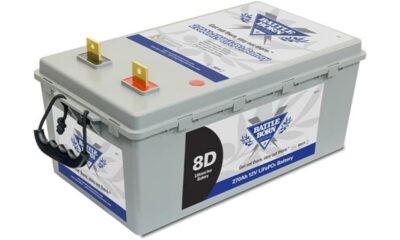
 Vetted5 months ago
Vetted5 months agoBattle Born Batteries Review: Reliable Power Solution
-

 Tableware and Dining Accessories7 months ago
Tableware and Dining Accessories7 months agoWhen Is Tableware on Sale at Hobby Lobby
-
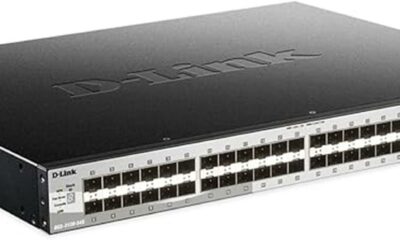
 Vetted5 months ago
Vetted5 months agoD-Link Switch Review: Lite Layer 3 Managed Networking




























